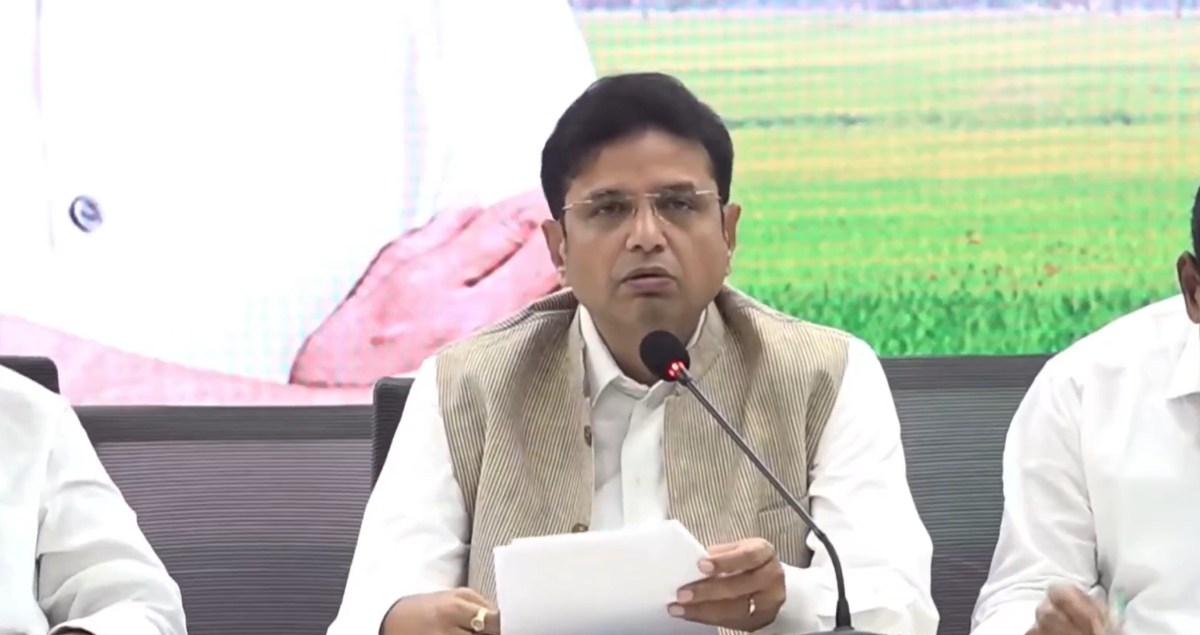The ministers justified bringing in the Hyderabad Indsutires Land Transforamtion (HILT).
Published Nov 25, 2025 | 8:51 PM ⚊ Updated Nov 25, 2025 | 8:51 PM

D Sridhar Babu. (Screengrab)
Synopsis: The meeting ran through a 10-item agenda that ranged from expansion of the GHMC and creation of a new DISCOM to major solar and pumped-storage power purchases, underground cabling for Hyderabad, and fresh infrastructure for education and sports.
The Telangana Cabinet headed by Chief Minister A Revanth Reddy on Tuesday, 25 November, approved a sweeping set of urban governance and power-sector reforms aimed at reshaping Hyderabad’s administrative footprint, strengthening electricity distribution, and attracting large-scale industrial investment.
The meeting ran through a 10-item agenda that ranged from expansion of the GHMC and creation of a new DISCOM to major solar and pumped-storage power purchases, underground cabling for Hyderabad, and fresh infrastructure for education and sports.
Below are the major decisions briefed to the media by Deputy Chief Minsiter Mallu Bhatti Vikramarka, Ministers D Sridhar Babu (Industries), N Uttam Kumar Reddy (Irrigation) and Jupalli Krishna Rao (Prohibiton and Excise) immediately after the cabinet meeting.
The ministers justified bringing in the Hyderabad Indsutires Land Transforamtion (HILT). Sridhar Babu, dismissed accusations of it being a “land scam” as baseless propaganda. He stressed that the policy will unlock underutilized industrial lands within the Outer Ring Road (ORR) to support the state’s investment goals.
The Cabinet approved the merger of 27 Urban Local Bodies (ULBs) located in and around the Outer Ring Road (ORR) into the Greater Hyderabad Municipal Corporation (GHMC). These include municipalities and municipal corporations situated both inside and abutting the ORR.
This is the biggest expansion of GHMC since 2007, when 12 municipalities and 8 gram panchayats were merged to form the present corporation. The latest move aims to bring uniform governance standards, improve infrastructure delivery, and rationalise urban planning across the fast-urbanising Hyderabad metropolitan region.
To enable the merger, the Cabinet approved amendments to the GHMC Act and the Telangana Municipalities Act. Once the legal process is completed, GHMC’s jurisdiction is expected to expand significantly, enhancing its administrative, financial, and planning responsibilities.
In another major structural reform in the power sector, the Cabinet approved the creation of a third electricity distribution company (DISCOM) in addition to the existing Northern (NPDCL) and Southern (SPDCL) DISCOMs.
The new DISCOM will handle a cluster of high-consumption segments such as Agricultural power connections, Lift irrigation schemes, Mission Bhagiratha, Safe drinking water schemes and Hyderabad Metropolitan Water Supply & Sewerage Board (HMWSSB) power connections.
The creation of a specialised DISCOM will help address operational challenges and reduce the financial burden currently weighing down SPDCL and NPDCL.
With electricity demand rising steadily and expected to surge over the next decade, the Cabinet held a detailed discussion on future energy needs and examined a comprehensive presentation by the Energy Department.
As part of the state’s renewable energy push mandated by new Union government norms, the Cabinet approved calling tenders for procurement of 3,000 MW of solar power. The decision is expected to help Telangana bridge peak-time shortages and improve its renewable energy share without long-term financial lock-ins.
Recognising the importance of round-the-clock renewable energy, the Cabinet decided to launch tenders for procurement of 2,000 MW of pumped-storage power, also on a five-year contract basis.
Pumped-storage systems, which store power by pumping water to elevated reservoirs during surplus times and releasing it during peak hours, are crucial for stabilising solar-heavy grids.
Beyond procurement, the government is moving aggressively to position Telangana as a pumped-storage energy hub. The Cabinet cleared permissions to set up 10,000 MW of pumped-storage power plants across suitable locations in the state.
The government will allot land and provide water to companies willing to set up plants.
Power generated must be sold first to Telangana DISCOMs under preferential agreements. Existing MoUs with DISCOMs will be re-examined for viability.
In a major boost to industrial competitiveness, the Cabinet approved a policy enabling new industries to generate their own power through captive renewable energy systems.
New industries can apply for captive power generation and will receive instant approvals. No upper limit on power generation capacity. Existing industries will continue under the current supply model.
The Cabinet approved the construction of a new 800 MW thermal power unit at Ramagundam Thermal Power Station under the supervision of NTPC. The cabinet also asked officials to examine the feasibility of similar NTPC-run plants at Palvancha and Makthal.
Before final approval, the government wants a comparative analysis of: Per-unit cost if constructed by NTPC, Per-unit cost if constructed through TS Genco.
The decision is part of the state’s strategy to balance renewable energy with stable base-load thermal capacity.
In a major urban infrastructure upgrade, the Cabinet approved the establishment of an underground electricity cabling system in Hyderabad, modeled on Bengaluru’s recent initiative. Preliminary estimates place the cost at ₹14,725 crore.
The plan includes:
Two key social infrastructure approvals were cleared:
These decisions are in line with with the government’s commitment to expand educational and sports facilities in remote and tribal areas.
To boost skill development, the Cabinet approved an Advanced Technology Centre (ATC) in the Jubilee Hills constituency.
Besides, six existing Industrial Training Institutes (ITIs) will receive new ATCs, taking the total number to 62 across the state. These centres will train youth in cutting-edge technologies, aligning with industry demand.
(Edited by Sumavarsha)
